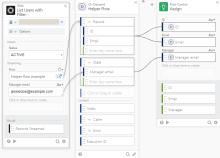Stream matching records with a helper flow
To use the streaming feature to pass data from a search or list card to a helper flow, perform the following steps:
-
Select Stream Matching Records on the action card (for example, the List Users with Filter action card for the Okta connector).
-
After selecting any desired input fields, click Save.
-
Click Choose Flow to open the Select flow dialog. Either select an existing helper flow from a folder, or click New Flow to create a helper flow.
-
If you made a new helper flow, click Add event and select Helper Flow.
-
In the helper flow, create two input entries: Record and State. Set the type for both fields to Object.
The helper flow requires the input fields to be named Record and State.
-
The Record object contains the current item that is being sent to the helper flow. You have access to all properties that are contained in the object.
-
The State object contains any additional inputs that you want the parent flow to send to the helper flow.
-
There's no output field on any action card to display streamed records.
Streamed record example
In this simple example, the Okta List Users with Filter card executes a search for users and then streams the records to a helper flow. The helper flow pulls the user's ID and Email fields and assigns a single manager's email address to the user.
To get the manager email to the helper flow, add a field labeled Manager Email to the Streaming section of the parent flow. In the field, enter the value to be sent. Then you reference that Manager Email field in the State section inside your helper flow.
The following diagram demonstrates the mappings of this specific example. The helper flow cards appear show the Record and State objects and their subsequent mappings to an Assign card.
Streamed data from the Okta user record is passed to the helper flow with the following structure:
{
"Record": {
"ID": "00u2unwcxjXHiqTES0g7",
"Last Name": "Hendrix",
"Activated": null,
"First Name": "James",
"Email": "jimihendrix@example.com",
"Created": "2021-09-27T22:23:55.000Z",
"Second Email": null,
"Raw Output": {
"id": "00u2unwcxjXHiqTES0g7",
"status": "ACTIVE",
"created": "2021-09-27T22:23:55.000Z",
"activated": null,
"statusChanged": "2021-09-27T22:25:36.000Z",
"lastLogin": "2023-11-14T17:51:00.000Z",
"lastUpdated": "2021-09-27T22:25:36.000Z",
"passwordChanged": "2021-09-27T22:25:36.000Z",
"type": {
"id": "00u2unwcxjXHiqTES0g7"
}
}
},
"State": {
"Manager email": "jessiedoe@example.com"
}For this user, the resulting Assign card in the helper flow has the following fields:
-
ID: 00u2unwcxjXHiqTES0g7
-
Email: jimihendrix@example.com
-
Manager: jessiedoe@example.com

